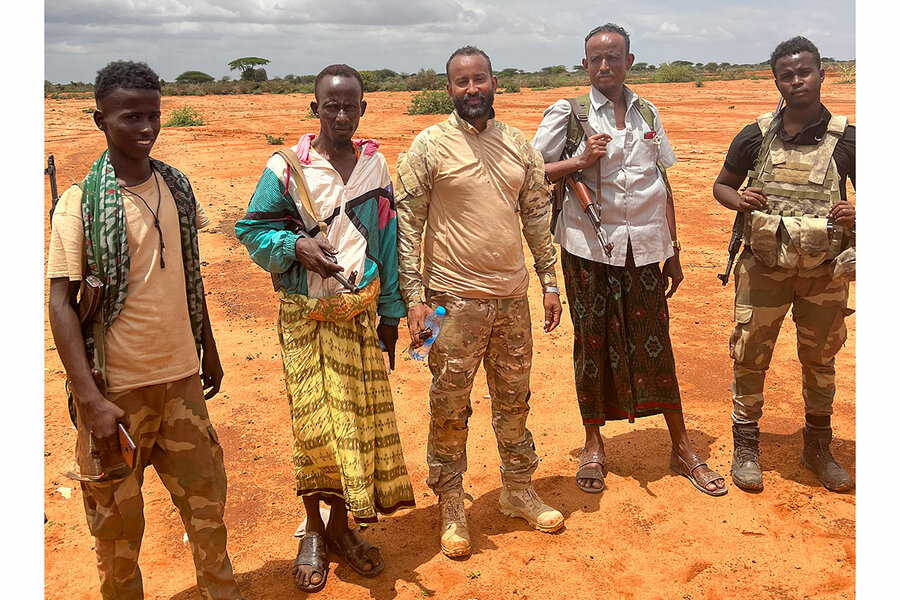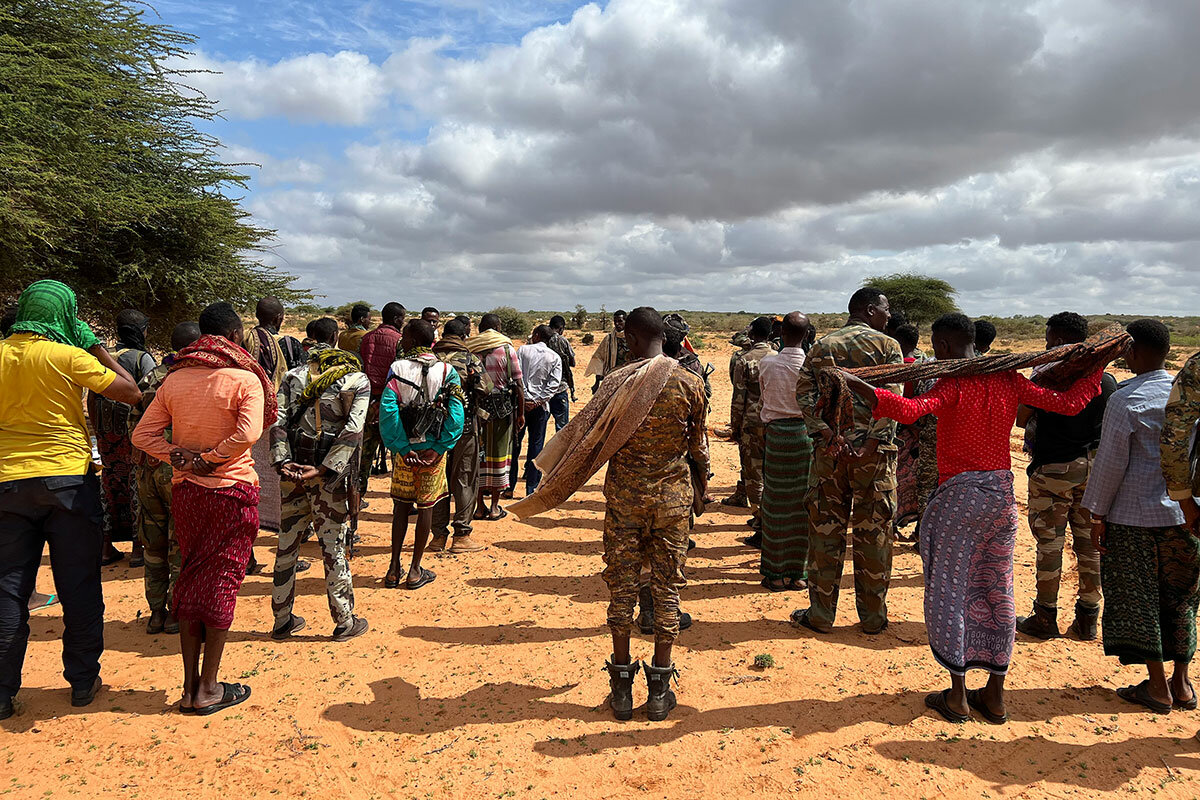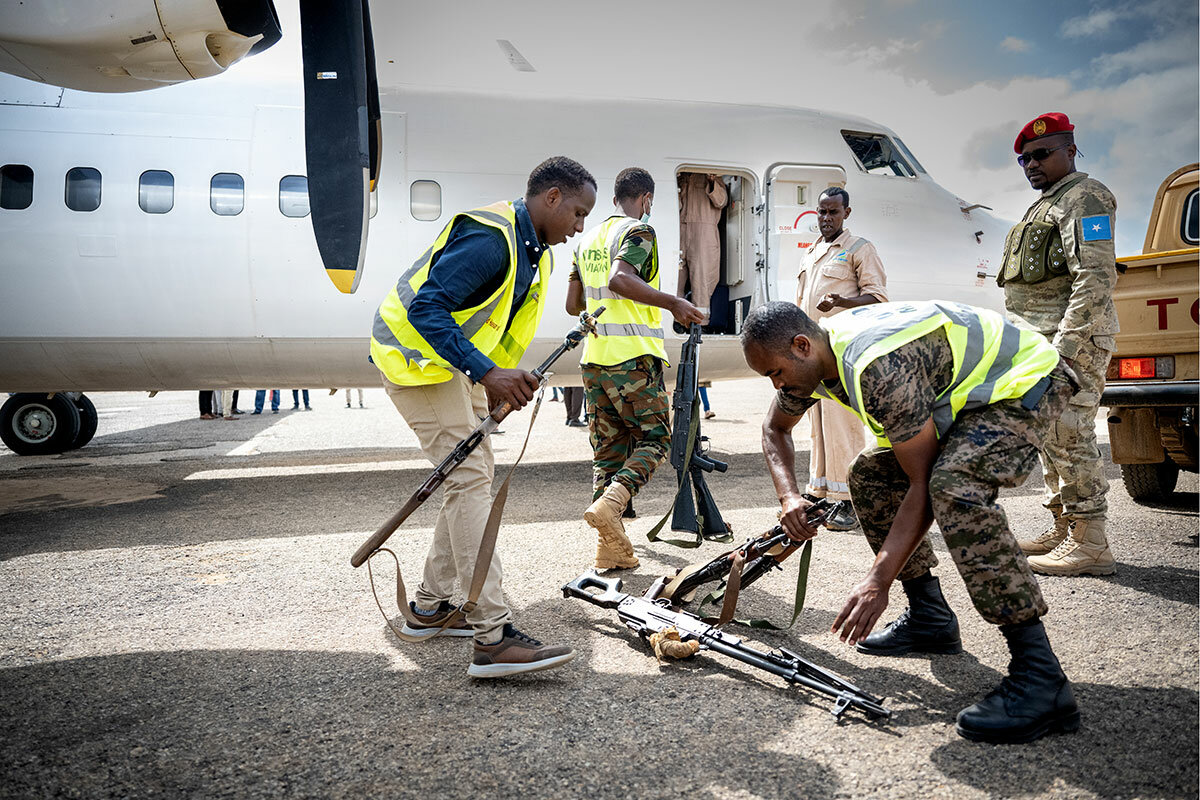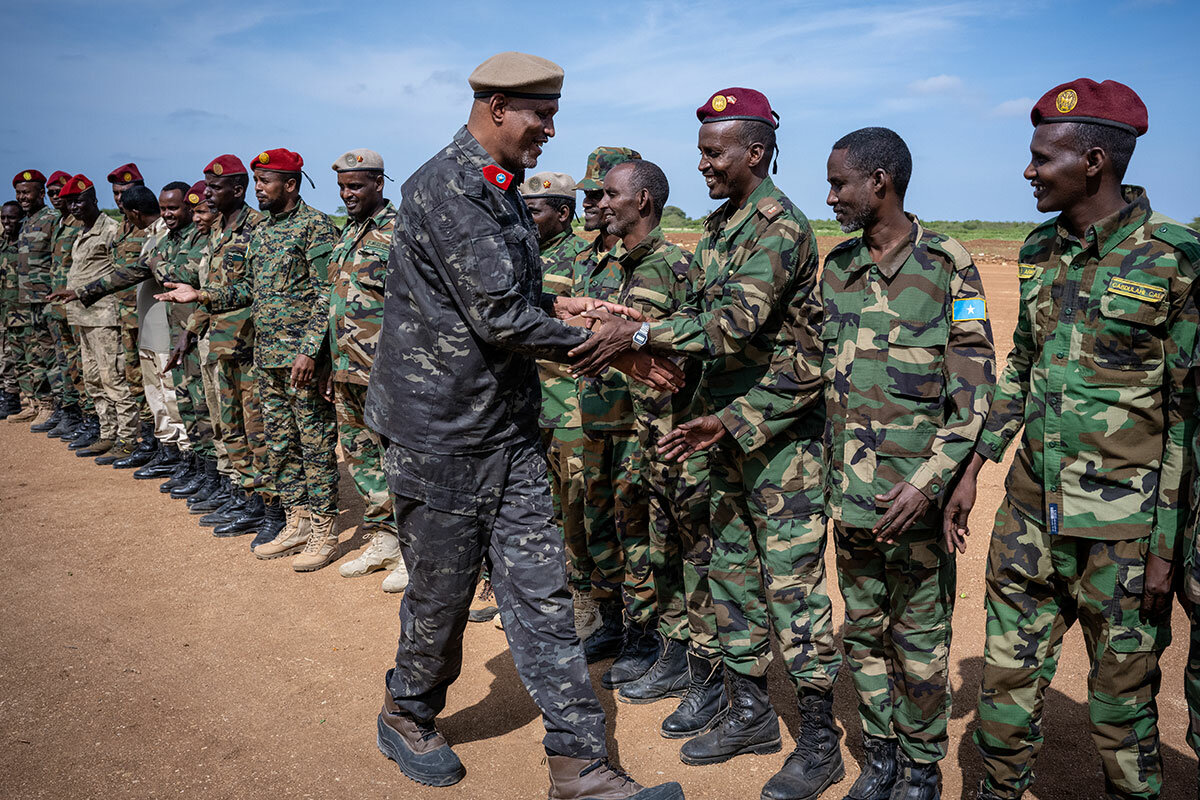Somalia rallies grassroots to oppose jihadist Al Shabab. Will it work?
| MOGADISHU, Somalia
Set in the middle of no man’s land, the desert village of Qoryaale had no presence of Somalia security forces, and Islamist Al Shabab militants were very close by.
Which is why Somali parliament member Malik Abdalla – driven to act by images of Al Shabab atrocities against civilians, and armed with the new Somali government’s determination to wage “total war” against the jihadis – went there in early October.
His aim: to mobilize local clans to join the most serious effort to date to take on the Islamists and end their 15-year insurgency by fighting alongside the Somali National Army (SNA) and American-trained Somali Special Forces.
Why We Wrote This
A story focused onSomalia has made surprising progress in its campaign against Al Shabab. Convincing its people that the jihadis are the enemy hasn’t been hard. The challenge is maintaining unity and solidifying territorial gains.
Using what he says was a loud voice, Mr. Abdalla called on village residents to bring out their guns and to overcome their suspicions after decades of government neglect, in a country beset by constant conflict and multiple droughts.
It was time to embrace cooperation and to fight back, he says he told them: “We cannot accept evil people telling us, ‘We will rule over you, and if you refuse, we will blow everything up.’”
Mr. Abdalla recalls that “some came out, and some were afraid.” And there were some younger, curious onlookers. “I told the children: ‘Go tell your parents to come out,’” he says.
Carrying just an AK-47 assault rifle, and with some of the new recruits, Mr. Abdalla says he set up a defensive line on the edge of the village and vowed to wait. Overnight, some residents sneaked out to speak to him.
Putting differences aside
It wasn’t difficult to convince them that Al Shabab was the enemy, he recalls. Still fresh is an incident from a few years ago when a dozen militants came to the village, killed two men, and dragged the bodies behind their vehicles.
But it was a challenge to persuade the locals to stand up and cooperate, and to convince them that Mr. Abdalla’s promise represented genuine official support. They told him that they did not need money, food, or weapons – only ammunition.
Videos online illustrate what was his winning argument to the villagers, as he tells fellow Somalis to set aside their clan differences and champion the fight against their common enemy.
Within four days, he had mobilized a local militia force that would grow to 600 men and women, opened a new front against Al Shabab, and demonstrated why the combined strength of Somali security units and clan militias have now recaptured more territory from Al Shabab in five months than in the previous five years.
“It is very motivating, because it is the first time that the Somali people can witness and see that the terrorists can be beaten, and can be defeated,” says Mr. Abdalla, a dual U.S.-Somali citizen with two degrees from The Ohio State University whose success at recruiting clan militias has become a replicated model.
“It’s a momentum that the government needs to take advantage of,” says Mr. Abdalla. “No matter if you are a big clan, or a small clan, you are a victim in your own country, you are a hostage in your own country.”
He notes increasing reports of violence by Al Shabab in south-central Somalia, including the burning of villages and destruction of water wells critical to survival after four failed rainy seasons. In response to the offensive, Al Shabab has also mounted attacks in major cities.
After a deadly hotel siege in Mogadishu in late August left more than 20 people dead, for example, Somali President Hassan Sheikh Mohamud declared “total war” against the Al Qaeda franchise. A double suicide car bomb in Mogadishu in late October also claimed more than 220 lives, among other complex attacks.
“They have reached their end,” says Mr. Abdalla. “They have shown that, even if you don’t fight them, they still will kill you.”
New government’s priority
The turnaround began in May, when President Mohamud took office and vowed to prioritize the fight against Al Shabab, despite looming humanitarian crises – including the worst drought in 40 years – that have left 7.8 million Somalis, nearly half the population, facing “acute food shortages,” according to the United Nations.
From July, government army units – spearheaded by the U.S.-trained Danab, or “Lightning,” Special Forces – have been joined by an ever-increasing number of mobilized clan militias, known locally as ma’awiisley, to jointly take on Al Shabab. The offensives have been backed by American and Turkish close air support and drone attacks, and African Union helicopter medical evacuations.
The speed and scale of success so far has surprised Somalis and analysts alike, but also raised questions about holding recaptured territory, maintaining momentum, and even the future potential danger of reinvigorating clan militias.
“Victory begets victory,” says a Western security official in Mogadishu, who asked not to be further identified because he was not authorized to speak to the press.
“What we are seeing here is a totally new approach” after 10 years in which the Somali federal government “tended to have more static operations” against Al Shabab, says the security official.
A catalyst for the strategy of enlisting clans came in June, he says, when the governor of Hiraan province grew fed up with Al Shabab probing near the city of Beled Weyne and mobilized the Hawadle clan to join the SNA to fight.
Another trigger came in early September, when Al Shabab stopped a humanitarian convoy of eight or nine trucks, burned the charitable donations gathered by one town to give to another, and singled out and executed a still undetermined number of Hawadle men, women, and children.
It was images of those killings that helped galvanize Mr. Abdalla’s decision to act, strengthening the government’s response, along with many Somali clans that had had enough.
Al Shabab’s “message”
This week the government-aligned forces recaptured the strategic city of Adan Yabaal, with its Al Shabab base, 150 miles north of Mogadishu. President Mohamud praised “important victories,” noting that Al Shabab is being “defeated in direct combat.”
“The SNA are probably feeling quite empowered, because these are the first large-scale, brigade-plus type of operations that they have done, and they have clearly had some successes,” says the Western security official.
But he notes that recaptured areas are not often held and developed, so security and humanitarian access has often barely improved. And Al Shabab has responded by hitting government recruiting centers and barracks, as well as bridges and telecommunications infrastructure, making it harder to move supplies.
“It is [Al Shabab] sending a message to the clans, ‘Don’t mess with us, or we’ll get back at you. … Don’t think we are on the back foot, we’re still a threat – we can still do what we want, when we want,’” says the security official. “There is a lot of [government] momentum to be maintained.”
And that is what Somali officials say they are determined to do, by directly taking on Al Shabab after what, by all accounts, was a five-year gap in pressuring the group by the previous government, from 2017 to 2022.
The previous administration “accepted cohabitation” with Al Shabab, says Hussein Sheikh Moalim, the national security adviser to the president. The result was a richer and “much more powerful enemy,” he says.
Nevertheless, he predicts, perhaps boldly, that Al Shabab will no longer hold any territory in Somalia within 18 months.
“We have studied Al Shabab and their weakness,” says Mr. Moalim. “They put all their emphasis on coercion, and not on winning hearts and minds.”
There had been some clan resistance to Al Shabab in recent years, he says, but it fizzled without government support. That is changing.
“For [the jihadist] insurgents to survive … the population has to believe in the cause they are fighting for, which has not existed for a very long time,” says Mr. Moalim.
“Our new strategy is to use the public against them, which is now working,” he says. “In a very short period, and with very little [government] resources, Al Shabab has been losing ground, day after day.”
Beyond people’s limits
The growing popular backlash could have devastating consequences for Al Shabab, which portrays its fight as a religious duty to impose their strict interpretation of Islamic law across Somalia.
“It’s very simple: Al Shabab has taken extreme measures to pressure the community; they have been squeezing, squeezing, squeezing,” says Abdisalam Guled, the former deputy director of intelligence for Somalia.
“I think they went beyond limits that people can tolerate,” he says. Local communities are now “desperate” and have weapons, after years of lawlessness. Besides ammunition, “the only thing missing was the enthusiastic moral support of the government.”
That support has created the most potent, unified anti-Shabab force ever to confront the jihadis.
“Al Shabab will fight back in Mogadishu, which is the most vulnerable,” says Mr. Guled. “They will make civilians suffer, and make the government feel it.”
Limiting that impact is the aim of Somali officials, who say they are already working on post-Shabab stabilization plans that include providing local governance and preventing a resurgence of clan rivalries that underpinned previous decades of conflict.
“There is a community uprising” against Al Shabab, says Abdirahman Abdishakur Warsame, the president’s envoy for drought response. “This war will give us ownership of Somalia.”









